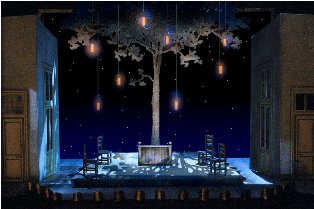
act four, "Le nozze di Figaro," University of Cincinnati College-Conservatory of Music, set design by Thomas C. Umfrid
|
You’ve heard of stand and sing opera. The University of Cincinnati College-Conservatory of Music’s "Le nozze di Figaro" ("The Marriage of Figaro") February 10 in Patricia Corbett Theater wasn’t it.
Perhaps it was the proximity to Valentine’s Day, perhaps it was the
youthful cast, but rarely has this reviewer seen so much clinching,
pinching, snuggling and just plain romancing on the opera stage. The
energy level was glandular, to say the least.
The singing was just as vibrant, leaving little to be desired in the
simple, but imaginative period production directed by CCM opera head
Robin Guarino and conducted by faculty member Annunziata Tomaro. Tomaro
led a 40-piece orchestra in the pit, with Megan Clewell on fortepiano. Scenic design was by CCM faculty designer Thomas C. Umfrid.
Mozart’s opera buffa, a madcap day in the life of a bored Count, his
neglected wife and a pair of servants about to be married, played out on
a wooden platform with a wall and doors at the back and two flanking,
well-used entrances and exits. Set changes, engineered by the cast, were
instantaneous, with chairs, ladders and a lantern-bedecked tree flown
in plain view. Costumes and wigs, designed and built by the student
production team, were refreshingly down-to-earth, with a minimum of
powdered wigs. (A historical consideration, said Guarino, was to
advance the time to just before the French Revolution, when aristocracy
was becoming frayed.)
The Overture, crisply led by Tomaro, played out to some provocative,
peek-a-boo toe-wiggling behind what looked like bed sheets hung across
the stage in act one. Cherubino and Barbarina (mezzo-soprano Katherine
Wakefield and soprano Sakinah Davis) broke it up at the Count’s
indignant prodding and the scene became the Count’s ante-room, where
Figaro and Susanna (Jose Rubio and Ji Hyun Jang) debated the pros and
cons of placing their soon-to-be nuptial bed next to the master’s
quarters. Rubio’s smooth, resonant baritone and Jang’s sweetly vivacious
soprano raised some sparks
ab initio, as did their bouncing and
fondling on the bed. Figaro’s "Se vuol ballare" ("If you wish to dance")
as the Count’s amorous designs on Susanna became clear, rang with
indignation.
The Count, handsomely portrayed and sung by baritone Mark Diamond, was a
tall, curly blond menace, his big voice complemented by that of soprano
Jacqueline Echols as the Countess. Her creamy tone and sympathetic
delivery made "Porgi amor ("God of love") and "Dove sono . . . i biei
momenti" ("Where are they, the beautiful moments") artistic highlights
of the evening. Katherine Wakefield as the chronically besotted
Cherubino set the tone for wayward romance, groping at every arm, leg,
nape and skirt within reach, while making his "Voi che sapete" ("You who
know") a tender love song. Having come under the jealous Count’s
suspicion, he was packed off to the military with zest by Figaro in his
"Non più andrai" ("No more will you go").
The supporting cast members were a lively bunch, both in comedic and
romantic terms. Bass Thomas Richards and soprano Jill Phillips (Bartolo
and Marcellina) plotted gleefully against Figaro, then embraced him
warmly (again and again) when his identity as their long lost son was
revealed, and delivered some of the funniest comic licks of the evening
as they agreed to a double wedding (Bartolo somewhat reluctantly). Bass
Timothy Bruno as the tipsy gardener Antonio was scruffy, bearded and
hilarious as he tried to fill in the blanks, while tenor Ian José
Ramirez as the music teacher Basilio waved a prissy baton at the peasant
chorus, come to thank the Count for having abolished the
droit du Seigneur.
Things came together splendidly in act four when everyone did it in the
dark. Figaro’s bitter diatribe against women was sung with the house
lights up so he could exhort the audience directly. Susanna (the
Countess in disguise) broke his heart ever so sweetly in her encounter
with the Count. Cherubino lusted after “Susanna” also, threatening to
spoil the plot to undo the Count’s lecherous behavior, and there was
much clutching in the dark.
The opera’s threat to become pure farce is redeemed, of course, when the
undisguised Countess walks on with the ring the Count has given her
while romancing her as Susanna. Diamond was on his knees at once with a
throaty "Contessa, perdono" ("Countess, forgive me") that restored
goodness and sanity in one fell stroke. It was a different kind of
reconciliation for Figaro and Susanna, a kind of jump for joy, as it
were, when after taking a battering from Susanna with a shoe for having
romancing her as the Countess (or pretending to), Rubio slid on his
tummy like a penguin to grab Jang’s legs and reveal that he knew she was
Susanna all along. Lights went up onstage for general rejoicing by the
talented ensemble cast.
Tomaro led a fine accompaniment and ensemble between stage and pit was
precise and well balanced. The fortepiano, a further touch of historical
authenticity and a pleasure to hear as performed by Clewell, was raised
almost to stage level to assist even further. Leading roles -- Figaro,
Susanna, the Count, Countess and Cherubino – were double cast for
performance on alternate days during the opera’s four-day run.
Repeats are 8 p.m. Feb. 11, 2:30 and 8 p.m. Feb. 12 and 2:30 p.m. Feb. 13 in Patricia Corbett Theater at CCM. Tickets ($27-$29 general admission, $17-$19 for students) at (513) 556-4183.